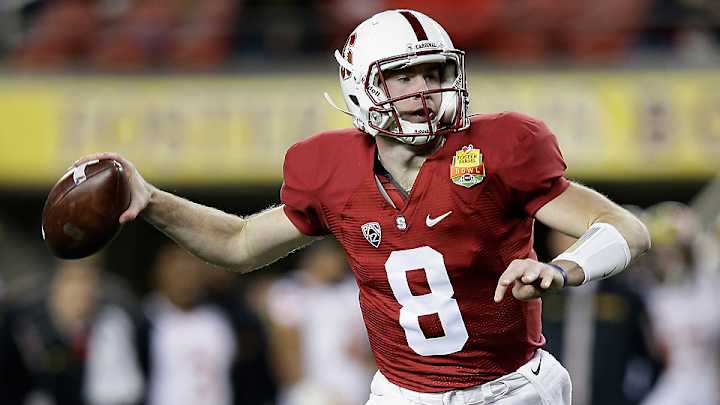Stanford routs Maryland, possibly ending Kevin Hogan's complex career

College football’s most unenviable successor, Kevin Hogan finished 2012 a Rose Bowl champion, a starting quarterback and the future leader of Stanford football. He wasn’t the first man to replace Andrew Luck (that was Josh Nunes, who Hogan replaced nine games into the 2012 campaign), but after the Cardinal’s Rose Bowl win over Wisconsin, Hogan was the future under center. Deceptively fast and properly disciplined despite his slow release, Hogan would never going to surpass Luck, one of the greatest college quarterbacks in recent memory, but he was a fitting replacement.
But Hogan didn’t play his (likely) final collegiate game on New Years Day. He wasn’t leading Stanford -- which won 44 games between 2010 and 2013 -- into a playoff game. Instead, he trotted out for warmups on the tattered turf of Levi’s Stadium, some 13 miles south of the Stanford campus, in 30 MPH wind before a smattering of fans in a sparsely populated pro stadium. Few care about the Foster Farms Bowl. Even fewer showed up to watch. A redshirt junior on track to graduate in June, it was probably Hogan’s last shot in a Stanford uniform. He hasn't addressed whether he'll return for his final year of eligibility, and head coach David Shaw intimated that Hogan didn't want to discuss it before the end of the season.
The Cardinal coasted to a 45-21 win over an overmatched Maryland, their eighth win of a confusing, disappointing 2014 campaign. Hogan finished 14-for-20 for 189 yards and two touchdowns. He tacked on 50 rushing yards on seven carries. Outside of the play of freshman sensation Christian McCaffrey -- a budding star at running back -- it was a boring game that could be gleaned from the box score.
But as he took his helmet off for the last time with 13 minutes left in the fourth quarter, one couldn’t help but think -- was this was it for Hogan?
Return to Ann Arbor: Jim Harbaugh explains his move back to Michigan
Stanford entered 2014 with a rebuilt defense, an enormous offensive line and a veteran quarterback. Some questioned its ability to win the Pac-12 without a clear starter at running back and last year’s defensive leaders (Trent Murphy, Shayne Skov, Ben Gardner), but the Cardinal thrived on doubt during its dominant run that started under Jim Harbaugh and concluded under David Shaw. This was the team that Oregon couldn’t beat, that kept reappearing in BCS games and fostered a fear in its conference opponents through its physicality and discipline. After Luck graduated, Hogan was one of the faces of Stanford’s persona: Bland, unspectacular and efficient.
STAPLES: Often overlooked, FSU's Greene set to cap stellar career
But the devotion to that physicality -- a bruising run game paced by the behemoth offensive line -- was its downfall in a season when it should have competed. While Hogan seldom faltered in crucial situations, he never engendered a trust in Shaw. Naturally conservative in his playcalling and devoted to a run game that started with Toby Gerhart and continued with Stepfan Taylor and Tyler Gaffney, Shaw focused his offense around his running game without an established starter. He had an electric wideout (Ty Montgomery), a blossoming tight end (Austin Hooper) and two more capable receivers (Devon Cajuste, Michael Rector) and Hogan, his starter since November 2012.
Oregon's defense seeking to make statement against FSU in Rose Bowl
But Shaw didn’t trust Hogan enough to open up the offense. Instead, he chose the run game. Stanford finished the season with 432 rushing attempts and 355 passing attempts. The team’s leading rusher (Remound Wright) finished the regular season with 552 yards, the lowest output of any leading back since 2007. Not one Stanford running back finished the season with a 100-yard game. The season wore on, the offense kept stalling and Stanford kept losing. First it was USC (3.3 yards per carry on 38 attempts), then Notre Dame (47 yards on 32 carries), then Arizona State (76 yards on 22 carries) and then Oregon (3.3 ypc on 39 attempts). A Pac-12 powerhouse since 2010, Stanford wasn't bowl-eligible until November 22nd.
But Shaw’s trust remained in the jumbo formations, not Hogan’s arm.
With a respectable 48 touchdowns against 21 interceptions (he never threw more than two in a game) in three seasons, Hogan may exit Stanford an embattled, unfulfilled quarterback. Defense and the run game lifted Stanford to two Rose Bowls in the last two years. This was supposed to be Hogan’s year, but he hardly got a shot to lead. Instead, he may have ended his career with a Foster Farms Bowl MVP.
Hogan spent what could be his final game finding Hooper over the middle, Cajuste on hitch routes and breaking off read-option runs. He looked like the complete college quarterback that most coaches would be happy to start. Elected to replace a legend, Hogan was bland, unspectacular and efficient. What he lacked was his coach's trust.
